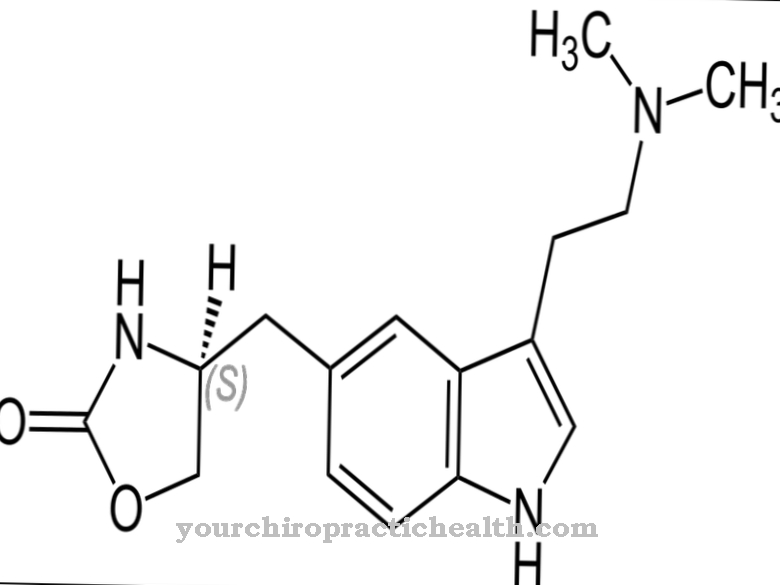At Ursodeoxycholic acid (also as Ursodeoxycholic acid called) it is a natural, tertiary bile acid. It is used to dissolve small gallstones (up to a maximum of 15 mm) and to treat certain diseases of the liver.
What is Ursodeoxycholic Acid?
From a chemical point of view, ursodeoxycholic acid (ursodeoxycholic acid) belongs to the group of sterols and is a steroid. It is a natural, tertiary bile acid that is partially synthetically produced by extracting cholic acid from the bile of slaughtered cattle. About 3 percent of the acid is also found in human bile.
Ursodeoxycholic acid (ursodeoxycholic acid) is primarily used to dissolve so-called cholesterol gallstones of small size. Ursodeoxycholic acid (ursodeoxycholic acid) is available in the form of film-coated tablets or capsules.
Pharmacological effect on the body and organs
Ursodeoxycholic acid (ursodeoxycholic acid) occurs in small amounts in natural bile acid and - unlike other bile acids - is soluble in water. The acid inhibits the absorption of cholesterol from the intestine and the release of cholesterol into the bile from the cells of the liver. By taking ursodeoxycholic acid (ursodeoxycholic acid), the mechanism is strengthened, the cholesterol in the bile decreases.
So it is much more finely distributed in the liquid. This leads to a gradual dissolution and flushing out of the cholesterol gallstones. The active ingredient also has a protective effect on the cells, preventing chronic inflammatory reactions. Ursodeoxycholic acid is non-toxic.
Medical application & use for treatment & prevention
Ursodeoxycholic acid is primarily used to dissolve cholesterol gallstones. The therapy is only possible with small stones up to a maximum of 15 mm and a functioning gall bladder.
The drug is also used when cirrhosis of the liver is not supposed to progress any further. However, this must be due to a chronic inflammation of the biliary tract and a backlog of the bile that forms in the liver cells.
Ursodeoxycholic acid is also used to treat certain types of inflammation of the gastric mucosa. Here the backflow of digestive juices from the duodenum into the stomach is inhibited.
Hypersensitivity to ursodeoxycholic acid, acute gallbladder and biliary tract inflammation, occlusion of the biliary tract, hepatitis (chronic or acute), calcium-containing gallstones (shadow in the X-ray), decreased gallbladder functionality, frequent biliary colic and non-gallbladder colic X-ray image of the gallbladder must not be used for treatment with ursodeoxycholic acid.
Administration during pregnancy is also not indicated, as the unborn child can develop malformations. Pregnancy must therefore be ruled out before starting therapy, and contraceptive measures are advisable during therapy.
Even if treatment with ursodeoxycholic acid is rare in children and adolescents, it can be used from the age of 6 if there is biliary obstruction. The duration of treatment with ursodeoxycholic acid is usually between 6 and 24 months.
Risks & side effects
The administration of ursodeoxycholic acid can also cause side effects. These differ from patient to patient. They can or do not have to occur. The most common side effects are mushy stools and diarrhea. In very rare cases, calcification of the gallstones, hives or severe pain in the upper abdomen can also occur. The latter side effect is particularly possible in the treatment of primary biliary liver cirrhosis.
If ursodeoxycholic acid is used to treat biliary cirrhosis of the liver in an advanced stage, it can worsen in very rare cases. As soon as the treatment is finished, regression usually occurs.
Interactions between taking ursodeoxycholic acid and taking other drugs at the same time are possible. Agents for binding bile acid (e.g. colestipol), agents for binding acid, clay or aluminum salts can lead to a reduction in the absorption of ursodeoxycholic acid from the intestine. In these cases, it should be taken at least 2 hours later.
If you take ciclosporin (a medicine to prevent transplant rejection) at the same time, the effects of ciclosporin are increased. Ursodeoxycholic acid, on the other hand, has a weakening effect on the antibiotic ciprofloxacin and the calcium blocker nitrendipine.
Especially at the beginning of therapy with ursodeoxycholic acid, regular monitoring of the liver enzyme levels in the blood by the attending physician is necessary, and the gall bladder should also be examined regularly using ultrasound. If the galls do not shrink within a year or they become calcified, the treatment should be stopped.



























